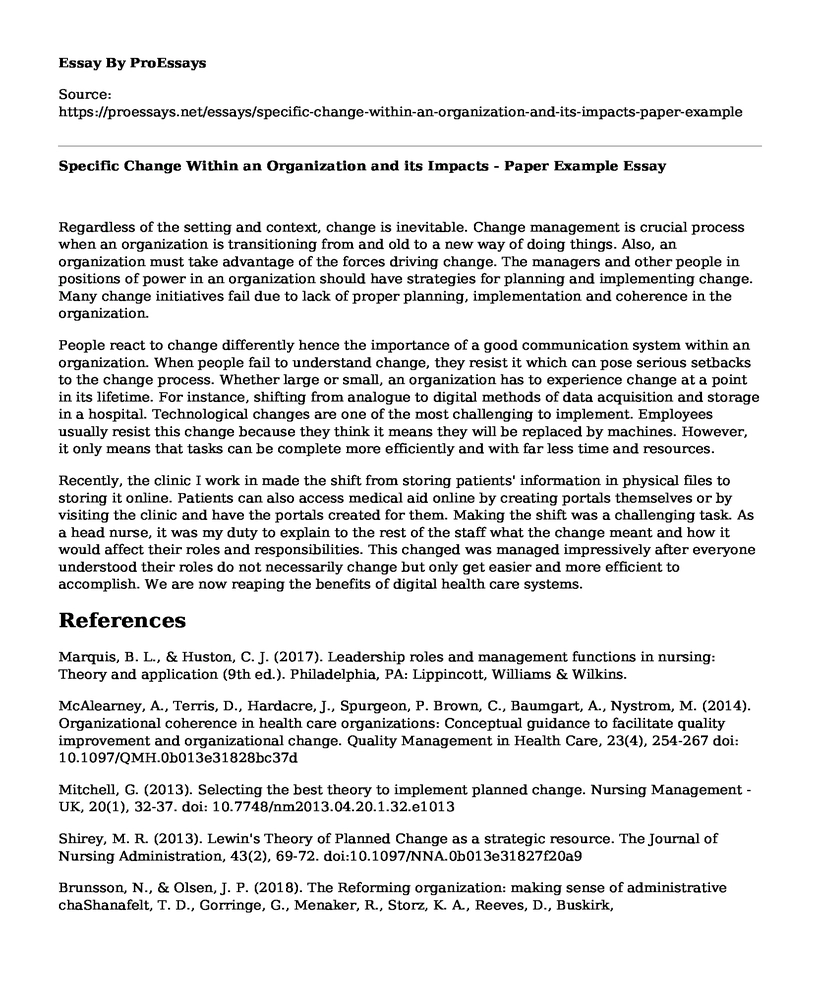Regardless of the setting and context, change is inevitable. Change management is crucial process when an organization is transitioning from and old to a new way of doing things. Also, an organization must take advantage of the forces driving change. The managers and other people in positions of power in an organization should have strategies for planning and implementing change. Many change initiatives fail due to lack of proper planning, implementation and coherence in the organization.
People react to change differently hence the importance of a good communication system within an organization. When people fail to understand change, they resist it which can pose serious setbacks to the change process. Whether large or small, an organization has to experience change at a point in its lifetime. For instance, shifting from analogue to digital methods of data acquisition and storage in a hospital. Technological changes are one of the most challenging to implement. Employees usually resist this change because they think it means they will be replaced by machines. However, it only means that tasks can be complete more efficiently and with far less time and resources.
Recently, the clinic I work in made the shift from storing patients' information in physical files to storing it online. Patients can also access medical aid online by creating portals themselves or by visiting the clinic and have the portals created for them. Making the shift was a challenging task. As a head nurse, it was my duty to explain to the rest of the staff what the change meant and how it would affect their roles and responsibilities. This changed was managed impressively after everyone understood their roles do not necessarily change but only get easier and more efficient to accomplish. We are now reaping the benefits of digital health care systems.
References
Marquis, B. L., & Huston, C. J. (2017). Leadership roles and management functions in nursing: Theory and application (9th ed.). Philadelphia, PA: Lippincott, Williams & Wilkins.
McAlearney, A., Terris, D., Hardacre, J., Spurgeon, P. Brown, C., Baumgart, A., Nystrom, M. (2014). Organizational coherence in health care organizations: Conceptual guidance to facilitate quality improvement and organizational change. Quality Management in Health Care, 23(4), 254-267 doi: 10.1097/QMH.0b013e31828bc37d
Mitchell, G. (2013). Selecting the best theory to implement planned change. Nursing Management - UK, 20(1), 32-37. doi: 10.7748/nm2013.04.20.1.32.e1013
Shirey, M. R. (2013). Lewin's Theory of Planned Change as a strategic resource. The Journal of Nursing Administration, 43(2), 69-72. doi:10.1097/NNA.0b013e31827f20a9
Brunsson, N., & Olsen, J. P. (2018). The Reforming organization: making sense of administrative chaShanafelt, T. D., Gorringe, G., Menaker, R., Storz, K. A., Reeves, D., Buskirk,
S. J., ... & Swensen, S. J. (2015, April). Impact of organizational leadership on physician burnout and satisfaction. In Mayo Clinic Proceedings (Vol. 90, No. 4, pp. 432-440). Elsevier.nge. Routledge. doi.org/10.1016/j.mayocp.2015.01.012
Cite this page
Specific Change Within an Organization and its Impacts - Paper Example. (2022, Dec 05). Retrieved from https://proessays.net/essays/specific-change-within-an-organization-and-its-impacts-paper-example
If you are the original author of this essay and no longer wish to have it published on the ProEssays website, please click below to request its removal:
- Food Matters - Essay Sample
- Paper Example on Trauma as Public Health Issue
- Determinants of Good Health - Essay Sample
- Essay Example on Stop Smoking: Poster Encourages Ethical Behavior and Prevention
- Essay Example on Social Work Practice: My Internship Experience
- Teamwork and Collaboration: Enhancing Healthcare Outcomes - Essay Sample
- Essay Example on Liquidation Damages: A Remedy for Breach of Contract







